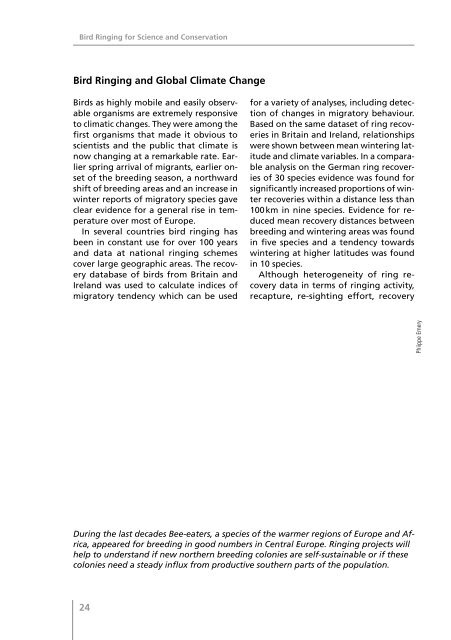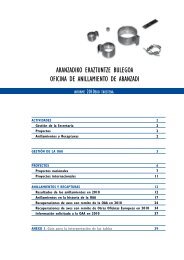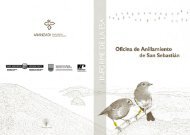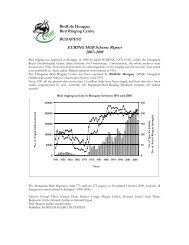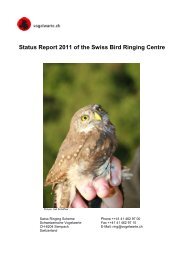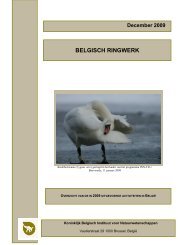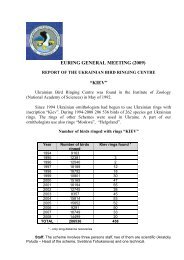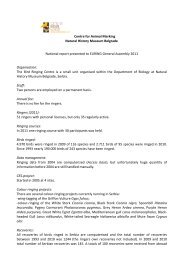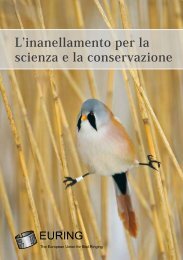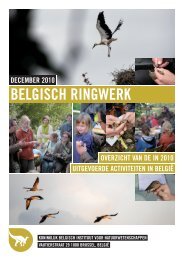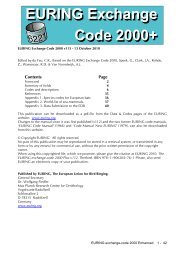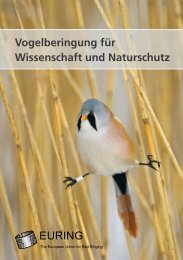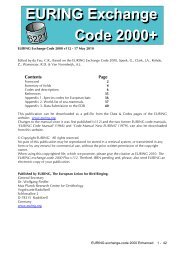Bird Ringing for Science and Conservation - The European Union ...
Bird Ringing for Science and Conservation - The European Union ...
Bird Ringing for Science and Conservation - The European Union ...
- No tags were found...
Create successful ePaper yourself
Turn your PDF publications into a flip-book with our unique Google optimized e-Paper software.
<strong>Bird</strong> <strong>Ringing</strong> <strong>for</strong> <strong>Science</strong> <strong>and</strong> <strong>Conservation</strong><br />
<strong>Bird</strong> <strong>Ringing</strong> <strong>for</strong> <strong>Science</strong> <strong>and</strong> <strong>Conservation</strong><br />
<strong>Bird</strong> <strong>Ringing</strong> <strong>and</strong> Global Climate Change<br />
<strong>Bird</strong>s as highly mobile <strong>and</strong> easily observable<br />
organisms are extremely responsive<br />
to climatic changes. <strong>The</strong>y were among the<br />
first organisms that made it obvious to<br />
scientists <strong>and</strong> the public that climate is<br />
now changing at a remarkable rate. Earlier<br />
spring arrival of migrants, earlier onset<br />
of the breeding season, a northward<br />
shift of breeding areas <strong>and</strong> an increase in<br />
winter reports of migratory species gave<br />
clear evidence <strong>for</strong> a general rise in temperature<br />
over most of Europe.<br />
In several countries bird ringing has<br />
been in constant use <strong>for</strong> over 100 years<br />
<strong>and</strong> data at national ringing schemes<br />
cover large geographic areas. <strong>The</strong> recovery<br />
database of birds from Britain <strong>and</strong><br />
Irel<strong>and</strong> was used to calculate indices of<br />
migratory tendency which can be used<br />
<strong>for</strong> a variety of analyses, including detection<br />
of changes in migratory behaviour.<br />
Based on the same dataset of ring recoveries<br />
in Britain <strong>and</strong> Irel<strong>and</strong>, relationships<br />
were shown between mean wintering latitude<br />
<strong>and</strong> climate variables. In a comparable<br />
analysis on the German ring recoveries<br />
of 30 species evidence was found <strong>for</strong><br />
significantly increased proportions of winter<br />
recoveries within a distance less than<br />
100 km in nine species. Evidence <strong>for</strong> reduced<br />
mean recovery distances between<br />
breeding <strong>and</strong> wintering areas was found<br />
in five species <strong>and</strong> a tendency towards<br />
wintering at higher latitudes was found<br />
in 10 species.<br />
Although heterogeneity of ring recovery<br />
data in terms of ringing activity,<br />
recapture, re-sighting ef<strong>for</strong>t, recovery<br />
<strong>and</strong> reporting probabilities of recoveries<br />
on a temporal <strong>and</strong> spatial scale are<br />
problems <strong>for</strong> these types of long-term<br />
analyses the data from bird ringing offer<br />
promising possibilities. First, ringing<br />
<strong>and</strong> recovery databases cover larger areas<br />
<strong>and</strong> longer time-spans than most single<br />
studies. Second, in contrast to pure<br />
observations <strong>and</strong> bird counts, individuals<br />
with deviant behaviour (like wintering in<br />
northern latitudes by migrants) can be assigned<br />
to distinct populations. Third, the<br />
datasets are readily available in st<strong>and</strong>ardised,<br />
electronic <strong>for</strong>mat. Thanks to the<br />
co-ordinating ef<strong>for</strong>ts of EURING, analyses<br />
of changes in migration behaviour of<br />
some species might cover many decades<br />
<strong>and</strong> large geographical areas. Furthermore<br />
the success of wintering attempts<br />
in northern latitudes, as well as fitness<br />
consequences of changed behaviour in<br />
response to any environmental change<br />
can only be measured properly when the<br />
bird is individually marked <strong>and</strong> can be<br />
recognized.<br />
Besides the current strong tendency to<br />
assign almost all observed changes in bird<br />
behaviour to climate change it must be<br />
kept in mind that also changes in l<strong>and</strong><br />
use, winter feeding, availability of rubbish<br />
dumps <strong>and</strong> many other environmental<br />
changes may affect the position of<br />
wintering areas <strong>and</strong> the timing of breeding<br />
behaviour. St<strong>and</strong>ardized data from<br />
ringing projects <strong>and</strong> the insights into life<br />
histories of individuals, as shown by ring<br />
recoveries, will help to entangle this complex<br />
framework.<br />
Phiippe Emery<br />
Tomi Muukkonen<br />
During the last decades Bee-eaters, a species of the warmer regions of Europe <strong>and</strong> Africa,<br />
appeared <strong>for</strong> breeding in good numbers in Central Europe. <strong>Ringing</strong> projects will<br />
help to underst<strong>and</strong> if new northern breeding colonies are self-sustainable or if these<br />
colonies need a steady influx from productive southern parts of the population.<br />
Swifts are among the species with increased reports of two subsequent broods instead<br />
of a single one per breeding season. But are the parents of both broods identical<br />
or did another pair start a late brood in the early ab<strong>and</strong>oned nest site of their<br />
predecessors Studies with individually marked birds can help to find the answer.<br />
24<br />
25


